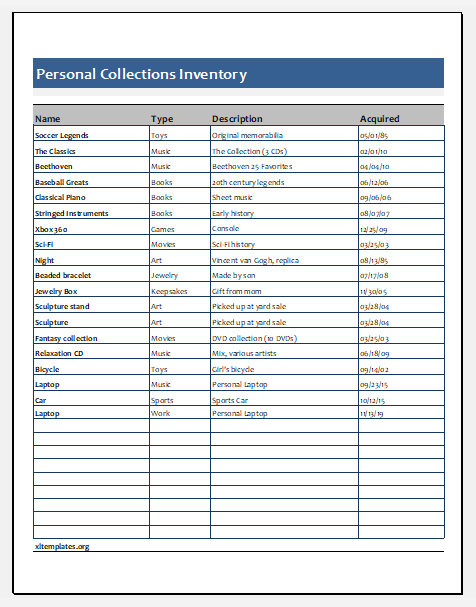Personal collection inventory is the managing and tracking of a person’s total collections (assets). We all know that inventory is the unsold items a person or businesses have in hand for use or sale. The personal collection varies from person to person depending upon the likes and dislikes or income level of an individual. It gives you an idea of what you have.
Inventory lists are not just dedicated to organizations or companies. Inventory lists can also be made by individuals that need to document all of their belongings for purposes like insurance, visas, loans and etc. This helps the individual in recording each and everything that he/she owns which could get him/her to achieve the purpose he/she wants to.
A personal collection may include:
- Books and magazines
- The currency of various countries (coins)
- Movie CDs
- Luxurious cars
- Clothing and shoes
- Property and gold
Whether you are a high salaried person or you belong to a low-income group, keeping track of your assets is not an easy job to be done. A personal collection inventory can be either done by:
- Holding a paper and pen.
- One might get the software and do this online with more accuracy. Authentic personal collection inventory software can be bought from reliable companies.
Keep bills and receipts of your most valuable assets to proof your possession.
The personal collection inventory basically organizes the total assets of an individual in a way that one should know:
- What you have
- Your backup of resources
- What you want to sell
- What you want to buy

File: Excel (.xlsx) 2007/10
Size 38 Kb | Download
Uses of having a personal collection inventory list:
Keeping a record of what you have in hand is a healthy activity. It can benefit a person in mentioned ways:
- Personal collection inventory list makes you efficient and practical, as you have a detailed list of all your assets and you are not missing anything.
- It is cost-effective and does not let you waste your money on things you already have or you don’t need in any way.
- It saves precious time and saves the person from the fuss of wasting hours on calculating his assets.
- It shows you what you need and what you want to buy.
- It tells you what items you want to sell out.
It may seem a simple task and keeping the track of your personal inventory and taking out the time to access and organize the personal collection inventory is great and very helpful. This process can be life-saving in a situation where an individual is in a financial crisis and needs to replace or sell out some of his assets. It gives quick access to your resources.
A personal inventory list should first be divided into groups. These groups could start off with bigger and valuable things to less valuable things. Property, cars, memberships, jewelry all come under valuable things whereas furniture comes under less valuable things.
If one wants they can also add a column which is dedicated to the price of each and every item on the list. Often there are times when one doesn’t know the exact price or prices have appreciated or depreciated over time. In this case, writing approx. is best. If you want you can get an estimate from a professional as well, but it could get rather costly.
Apart from maintaining an inventory list for insurance, visas, and loans, many people prefer maintaining a personal inventory list so that they have an idea of what they own. They can also be used when an individual is moving and upon reaching the new destination has a list so he/she could check whether everything came or if something has been misplaced.
Maintaining an inventory list is hard work, but if without fail, one remembers to put down an item the day it is purchased, it wouldn’t need a lot of time and effort.
